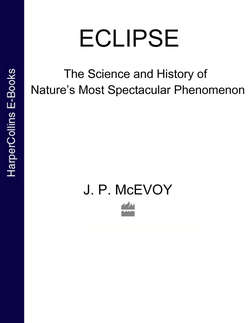Читать книгу Eclipse: The science and history of nature's most spectacular phenomenon - J. McEvoy P. - Страница 7
ОглавлениеPROLOGUE
Darkness at Noon: Baja Mexico, 11 July 1991
Stretching over 1,300 km south of the California state line between San Diego and Tijuana is a peninsula of mountains, deserts and plains ending at one of the most beautiful beaches in the world. Fine golden sand for miles and miles slopes into the azure Sea of Cortés and the Pacific Ocean. The peninsula, called Baja California, is actually part of Mexico. In the heat of the summer of 1991 I arrived, planning to view my first total eclipse of the Sun.
The morning of 11 August is bright and clear. Amid the palm trees and cactus plants all along the beach, tripods are being set up in the sand, an army of straw hats and Bermuda shorts appear as far as the eye can see. Everyone is buoyant. Not a single cloud in the sky, though still a few hours to go. Totality would be unusually long today at Los Cabos, 6 minutes 26 seconds, close to the theoretical maximum for a solar eclipse. The Moon’s shadow, when it reaches Baja, will be 260 km wide, moving along the beach at a speed of about 40 km per minute. As the bell in the small church tolls 10:00 a.m., the crowd makes final adjustments to telescopes and cameras. The long wait is over. Twenty-three minutes to go.
First contact occurs at 10:23:17 as the Moon’s disk just touches the Sun’s. The sky continues to be cloudless and no one is thinking of the weather. The show has begun.
In earlier times humanity held its breath during this solar disappearing act, offering sacrifices to appease the evil spirits who might destroy humanity’s source of heat and life itself. Slowly the Moon cuts deeper and deeper into the Suns image and it is now obvious that the two disks have the same diameter, a remarkable coincidence. The light fades imperceptibly.
Two small Japanese girls watch the progress of the eclipse through special Mylar sunglasses, while their mother watches anxiously. The Moon’s shadow is now sweeping across the globe towards us on the beach at Los Cabos at twice the speed of Concorde. In an orbit above the earth, a weather satellite photographs the shadow of the Moon every half-hour during its journey.
As second contact approaches, the Sun has been reduced to a thin crescent and now breaks up into a string of bright beads. These are known as Baily’s beads, caused by the streaming of the last rays of sunlight between mountains at the edge of the Moon. One by one the beads disappear until only one is left, radiating brightly from a single point on the edge of the eclipse, like a diamond ring.
Baily’s beads
My watch reads 11:47:40 and the miracle happens: second contact. The diamond ring disappears and a delicate pearly white halo springs into view around the eclipsed Sun. This is the corona. I have 6 minutes and 26 seconds. I look at the sky map and locate four planets in the noonday sky, lined up just to the east of the eclipsed Sun. Mercury and Jupiter are the closest, then Mars and Venus. The twin stars Castor and Pollux are clear and bright in the darkened sky, quite near the Sun. Sirius is just due south of the Sun. Through my telescope I see massive pink gaseous formations floating in the Sun’s atmosphere, the solar prominences.
The diamond ring
I look away at my fellow sky-gazers along the beach. It is like a scene from Spielberg’s Close Encounters of the Third Kind. Hundreds stand transfixed, motionless, staring directly up into the sky. No goggles or Mylar glasses are needed now. There is not a sound – even birds have stopped chirping. In the distance, I see what appears to be a sunset in all directions, 360° around the horizon. This is the illuminated Earth outside the canopy of darkness under the Moon’s shadow.
I check my stopwatch as third contact approaches. Then at 11:54:06, the corona disappears. In its place, the diamond ring effect and Baily’s beads repeat in reverse order. Cheers of excitement ripple through the crowd. A sliver of sunlight is now visible, and safety viewing devices are taken up to guard against the invisible ultraviolet waves. The Darkness at Noon is over.
The corona
One hour, fourteen minutes and forty seconds later, fourth contact occurs at 13:18:46. The Moon moves away from the Sun and the full disk returns. Everyone seems satisfied. The eclipse-chasers of the world have had their day in the Moon’s shadow. The travel, the hassles, the expense have all been worth it, viewing one of the greatest eclipses of the twentieth century.
